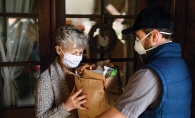At its 23,000-square-foot commercial facility in White Bear Lake, Grandma’s Bakery uses about 1,200 pounds of soybean oil per week. The bakery used to buy the oil in 35-pound cardboard jugs, packaged inside heavy-duty cardboard boxes. Those boxes “can’t be crushed down,” according to owner John Lupo. They took a lot of space in trash-hauling trucks and the county landfill—at a time when shrinking landfill capacity is a major problem for local governments.
But in recent years, Grandma’s has greatly reduced its waste stream and disposal costs by embracing recycling practices featured in the BizRecycling program, a free program offered to businesses (or other organizations) by Ramsey and Washington counties. Each participating business is connected with a consultant who conducts a free, 30-minute waste assessment, and then offers advice for designing a new or improved recycling and/or organics collection program to fit the business owner’s needs. Businesses are responsible for buying recycling bins, but they can apply for grant funding to cover the cost.
The program offers grants of up to $10,000 which can be used to cover the cost of minor construction, such as expanding a loading dock, according to Zack Hansen, environmental health director for the St. Paul-Ramsey County Department of Public Health.
Tom Snell, executive director of the White Bear Area Chamber of Commerce, says approximately 40 area businesses have requested no-obligation trash recycling audits from Minnesota Waste Wise. Snell says several chamber members have saved disposal costs by participating in the BizRecycling program, which he calls “incredibly important” in its contribution to reducing the waste stream being sent to local landfills.
Grandma’s Bakery “started recycling on our own a number of years back, but we didn’t have a great plan,” Lupo says. Beginning with recycling glass, cardboard and organic waste at the small bakery/coffee shop, the initiative was well-received by employees and customers. “We saw the reaction and decided to do it at the big plant,” says Lupo, who founded the business as a small retail shop in 1978. Today, Grandma’s has about 135 employees, producing baked goods for approximately 250 retail outlets.
One of the first things Lupo did after joining the program was find a supplier that would deliver soybean oil in bulk, eliminating the container waste. “That was huge,” he says. Also, the bakery has a large amount of organic (food) waste from its baking operation. Another move was connecting with a company in Rosemount, which turns it into feed for farm animals.
Grandma’s used principles it learned at the small bakery, in a scaled-up version, at the factory facility—like strategically placing color-coded waste cans (blue and green for recyclables, black for paper to be shredded, gray for trash). “We found that if you don’t make recycling easy, [people] won’t do it,” says Lupo, who adds that the business now recycles about two-thirds of its paper, glass, metal and food waste.
Earlier this year, the Lodge of White Bear won a workplace waste reduction and recycling award from the White Bear Area Chamber of Commerce. In its first two years of the program, the facility, which has 116 senior apartments, reduced its waste disposal costs by 42 percent, according to general manager Bill Duerre.
When the program was launched, “it probably took a good month to get everything organized,” Duerre says, but using color-coded containers in apartments, kitchens, and dining and laundry rooms, has made it easier to keep recyclables separate from waste. “The key is making it convenient for the employees and residents. It’s all in the containers.”









